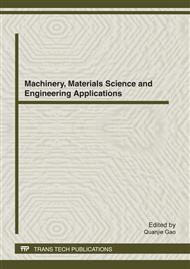p.431
p.437
p.442
p.446
p.451
p.455
p.458
p.467
p.472
The Influence of Cutting Depth on Residual Stresses when Orthogonal Dry Cutting GH4169 with High Speed
Abstract:
An finite element model of orthogonal dry cutting with separate line is established according to the constitutive relation of large thermo-elastic-plastic displacement and the principle of virtual work in metal plastic deformation process,. The influence of cutting depth on residual stress was simulated for materials GH4169 with high speed. The residual stresses are analyzed on the machined surface and subsurface. The result shows that tensile residual stress of the machined surface is minimum value when the cutting depth is 0.2mm. the deeper is the depth of cut, the large the augmentation of compressive stress on the subsurface, which proves foundation for cutting process of dry-machined difficult-to-machine material with high speed and make it more efficiently to control the integrity of the machined surface.
Info:
Periodical:
Pages:
451-454
Citation:
Online since:
April 2012
Authors:
Price:
Сopyright:
© 2012 Trans Tech Publications Ltd. All Rights Reserved
Share:
Citation:


